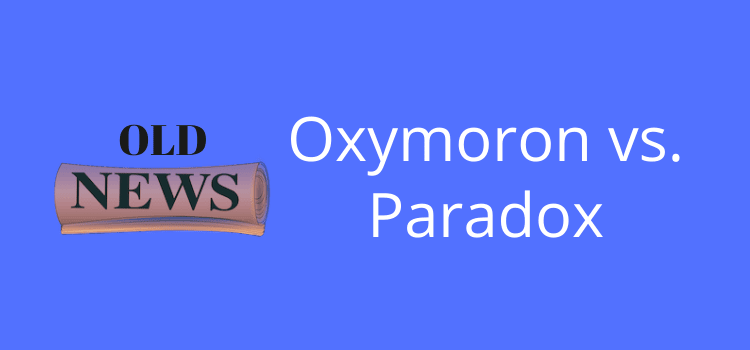An oxymoron and paradox are similar literary devices because apparently contradictory terms appear together.
While they are alike, they differ in their construction.
An oxymoron usually consists of only two or possibly three words. Examples include pretty ugly, original copy, and think out loud.
A paradox, on the other hand, is a sentence that often leads to a conclusion that seems illogical or self-contradictory. A good example is that if I know one thing for sure, it’s that I know nothing.
Oxymorons are easy to use in your writing
Because oxymorons involve two opposite words, it’s an easy device for writers to use in their writing.
There’s nothing I like better than a dark pale beer.
It’s as simple as that.
All you need to do is find contradictory pair words.
But they need to work together even though they are opposing.
They are fun, playful, and an excellent way for writers to add some wit to their writing. But it’s serious fun.
You might only be an advanced beginner at writing, but you can quickly learn how to use this device.
However, some oxymorons can relay a deeper meaning, such as bittersweet.
It means that something or someone arouses pleasure but with traces of sadness or pain.
Having a love-hate relationship is another that has a dark edge.
One of the most famous is a line from Romeo and Juliette by William Shakespeare.
Parting is such sweet sorrow.
There are so many oxymorons that we use every day.
But there’s no reason why you can’t invent your own.
The structure of a paradox
An oxymoron and paradox both use contradiction.
But a paradox is a rhetorical device that uses a sentence or sentences that could be contradictory or ridiculous but, in reality, describe a potential truth.
Most authors use paradox. But here are a few well-known examples.
“I can resist anything but temptation.” Oscar Wilde
“All animals are equal, but some are more equal than others.” George Orwell – Animal Farm
“I am Dead, but it’s not so bad. I’ve learned to live with it.” Isaac Marion, Warm Bodies
“Good judgment is the result of experience and experience the result of bad judgment.” Mark Twain
We also use everyday expressions and idioms that are a paradox.
“The only constant” is change.” Heraclitus – Greek philosopher
“The more I learn, the more I realize how much I don’t know.” Alber” Einstein
“Actions speak louder than words.” Melancholy State of Province -1736
Because paradoxes need a clear contradiction as well as an element of truth, they are not as easy to create as oxymorons.
But for new writers, there’s nothing to stop you from trying once you know the syntax and structure.
Related literary devices
Antithesis is closely related because it uses opposites.
You can find this device in all forms of writing and many famous quotes.
“That’s one small step for man, one giant leap for mankind.” Neil Armstrong.
In this quote, small step and leap are direct opposites.
“It was the best of times, it was the worst of times, it was the age of wisdom, it was the age of foolishness…” Charles Dickens – A Tale of Two Cities
Here the best and worst, and wisdom and foolishness are the antithesis of each other.
“We notice things that don’t work. We don’t notice things that do. We notice computers, we don’t notice pennies. We notice e-book readers, we don’t notice books.” Douglas Adams – The Salmon of Doubt
Here Adams simply uses do and don’t. He used a similar formula for this famous phrase.
“The ships hung in the sky in much the same way that bricks don’t.” Douglas Adams – The Hitchhiker’s Guide to the Galaxy
Juxtaposition is another form of paradox. It generally uses two things close together to create a contrasting effect.
Common examples include:
When the cat’s away, the mice will play.
Making a mountain out of a molehill.
All’s fair in love and war.
Irony is another form. It is when something is contrary to what is expected, and the result can sometimes be amusing.
There are three forms; situational, verbal, and dramatic.
But here are some general examples.
An English teacher fails a grammar test.
A member of the cabin crew is afraid of heights.
Water, water everywhere, nor any a drop to drink.
Summary of contradictory literary devices
While oxymoron and paradox are the most common forms of contradiction, there are many others.
They are a group of literary devices that all new writers should practice how to use.
You won’t always write a winning line, but you will learn as you try.
We all know that opposites attract, and they can perform a function in your writing.
All you need to do is think about how you can use opposites or contradictory statements to arouse a reader’s interest or to intrigue them.
The post Oxymoron And Paradox Are The Same Yet Different appeared first on Just Publishing Advice For Writers and Authors.
Go to Source
Author: Derek Haines
